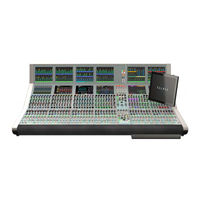
Calrec Apollo Manuals
Manuals and User Guides for Calrec Apollo. We have 3 Calrec Apollo manuals available for free PDF download: Operator's Manual, Installation & Technical Manual, Installation Manual
Calrec Apollo Operator's Manual (214 pages)
Digital Broadcast Production Console
Brand: Calrec
|
Category: Music Mixer
|
Size: 17 MB
Table of Contents
-
Layers1
-
Introduction
11 -
-
-
Buttons20
-
Control Cell20
-
Button Cell20
-
Strip20
-
Rows20
-
Panel Modes35
-
User Splits38
-
Layers39
-
A/B Paths39
-
Using Layers39
-
Layer Split39
-
-
-
Processing42
-
Send-Route43
-
Output Mode44
-
Monitor Mode45
-
Wilds Mode46
-
Strips Mode50
-
-
-
-
Input Ports55
-
Port Labels55
-
Port Lists56
-
Sets56
-
-
-
Input Trim68
-
Tone68
-
Input Delay68
-
L>B and R>B69
-
M-S69
-
Src69
-
Signal Flow69
-
Replay70
-
Alias Files75
-
-
Dynamics 187
-
Dynamics 290
-
Automixer91
-
Delay93
-
Stereo Width95
-
Inserts101
-
Creating Lists102
-
Renaming Lists103
-
Removing Lists103
-
VCA Groups104
-
Group Hierarchy104
-
Autofaders106
-
Routing Audio
111-
Buses Overview112
-
Making a Route114
-
Panning116
-
Joystick Panning117
-
-
Removing Sends123
-
Partial Sends123
-
-
Downmixes124
-
-
-
Output Control132
-
Tone to Mains134
-
Direct Outputs135
-
Monitor Mode138
-
Communications
153 -
Metering
159-
TFT Meters160
-
Meter Assignment161
-
Dynamics Meters162
-
A/B Path Meters162
-
-
-
Fader Meters164
-
Dynamics Meters164
-
-
Loudness Meters166
-
-
Overview170
-
-
Renaming Shows174
-
Deleting Shows174
-
-
Remote Control176
-
-
Memory Isolation177
-
Presets181
-
Loading a Preset181
-
Editing a Preset181
-
Pooled Resources182
-
-
-
-
System Reset185
-
Reset Buttons185
-
Technician Mode186
-
-
-
Gpio190
-
Assigning Gpis190
-
GPI Functions190
-
Assigning Gpos191
-
GPO Signal Type191
-
Test GPO191
-
-
Remote Control193
-
Ember193
-
Cscp193
-
CSCP Per Fader193
-
-
MIC Open Systems195
-
-
Spill Automation197
-
Editing Suite197
-
Redundancy197
-
-
-
System Status
199
Advertisement
Calrec Apollo Installation & Technical Manual (124 pages)
Brand: Calrec
|
Category: Music Mixer
|
Size: 13 MB
Table of Contents
-
-
System PC26
-
-
Serial Port27
-
Backup PC28
-
-
-
GP Inputs50
-
GP Outputs50
-
-
-
RTW Meters56
-
DK Meters57
-
-
-
Connection60
-
-
-
Connection61
-
-
-
-
Sync Setup77
-
Using Tone81
-
-
-
Connections94
-
-
-
Connections95
-
-
-
Connections96
-
-
-
Connections97
-
-
-
Connections98
-
-
-
Connections99
-
-
-
Connections100
-
-
Dk Msd600102
-
Meter - MU5799102
-
Connections102
-
-
-
Connections103
-
-
-
Resets107
-
Talkback MIC107
-
USB Port107
-
Connections107
-
-
-
-
-
Connections110
-
Level110
-
-
-
Connections111
-
Level111
-
L/R or M/S111
-
-
-
Connections112
-
-
-
Connections113
-
-
-
-
Connections114
-
-
Specifications
115
Calrec Apollo Installation Manual (68 pages)
Digital Broadcast Production Console
Brand: Calrec
|
Category: Recording Equipment
|
Size: 9 MB
Table of Contents
Advertisement


